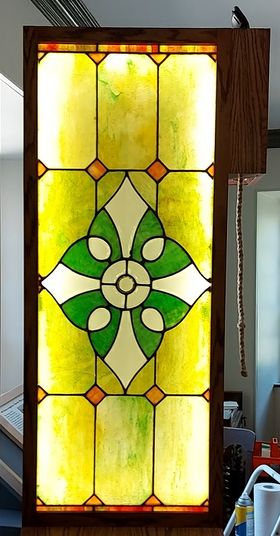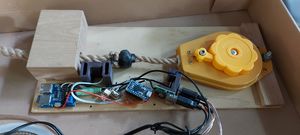Stained Glass Backlighting Display: Difference between revisions
Appearance
Ttenbergen (talk | contribs) No edit summary |
Ttenbergen (talk | contribs) No edit summary |
||
| Line 1: | Line 1: | ||
{{Project | | {{Project | | ||
| shortDescription = | | shortDescription = Battery operated display that uses a rope pull to turn on an audio file and LED backlighting. | ||
| longDescription = | | longDescription = | ||
The [[St. Andrews Heritage Centre]] wanted a battery operated display for a stained glass panel that would fade on lights and play church bells when a rope is pulled. The light then dims back down and the church bells end after a period. | |||
We set up the mechanism to pull the rope to trigger a hall sensor, which is read by an [[Arduino]]. The Arduino then provides a PWM signal to an LED driver to fade on a string of LEDs, and starts to play an MP3 file of the church bells. The display is powered by a USB battery pack which | We set up the mechanism to pull the rope to trigger a hall sensor, which is read by an [[Arduino]]. The Arduino then provides a PWM signal to an LED driver to fade on a string of LEDs, and starts to play an MP3 file of the church bells. The display is powered by a USB battery pack which | ||
Revision as of 20:00, 2021 October 23
| Projects | |

| |
| Project: | Stained Glass Backlighting Display (I) |
| Description: | Battery operated display that uses a rope pull to turn on an audio file and LED backlighting. |
| Skillset(s) : | |
| Project Type(s) : | |
The St. Andrews Heritage Centre wanted a battery operated display for a stained glass panel that would fade on lights and play church bells when a rope is pulled. The light then dims back down and the church bells end after a period.
We set up the mechanism to pull the rope to trigger a hall sensor, which is read by an Arduino. The Arduino then provides a PWM signal to an LED driver to fade on a string of LEDs, and starts to play an MP3 file of the church bells. The display is powered by a USB battery pack which
